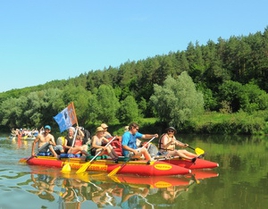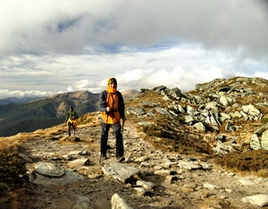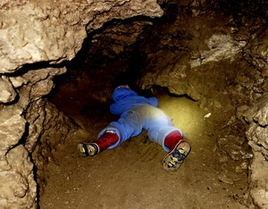Atlantyda Cave
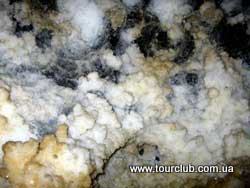
Among karst caves of Ukraine Atlantyda takes a unique place. It is located in the scenic valley slope of the river Zbruch near the village of Zavallya, of Kamyanets-Podilskyi district, Khmelnytskyi region. The legend tells that at the upper part of the slope, over the cave, there once was a small church. One day it “collapsed” into a karst abyss, the village was called Zavallya (rubble) after it. The cave was not known at that time, but people realized that such phenomena are linked with cavities in the ground.
An open quarry for gypsum mining was open in the fifties at the valley slope. It did not operate for long, as in the 18 meters layer of gypsum a lot of big and small cavities were found. In the quarry wall there were several cave holes, which were left unseen for a long time.
In 1968 young Kyiv speleologists examined these holes. Behind one of them they found a small cave that ended with clay-covered paths. In order to dig the passageway, which seemed to be promising to speleologists, they organized several expeditions. And finally, in summer of 1969, multimeter excavation brought to the hall, which served as the start of a large cave system. The first superficial examination showed its unusual character. Clear sculptural forms of passages and halls that are located in three tiers, a variety of fine gypsum crystals in different shapes and colors - these and other features put this peculiar palace in a row with the most original gypsum caves of Ukraine.
The name “Atlantyda”, associated with mystery and beauty, was born quickly. And here are the exact parameters of the cave: Total length – 2525 m, area – 4440 m2, capacity – 11360 m3. Its structure is complex enough. The volumetric and high galleries of the lower tier, so called arterial roads, formed with powerful local underground streams, make up basis for a spacious structure. At the same level, in the bottom part of the gypsum layer, there are lower passages, called “cellars”. They turn away from arterial roads and form small labyrinths. At the intersection of roads and passageways of the second tier there are big halls, such as “Dynamo”, “Pokoryteli” (Conquerors), “Kyiv Speleologists”. Their area reaches up to 400 m, the height is up to 12 m.
The passageways of the second tier are 8-9 m higher. They are much narrower than the roads (1-1,5 m), but rather high and clearly show the systems of tectonic cavities, under which they were developed. These passageways, more often, then the roads, from both sides finish with dead ends. At some parts passageways of the second tier form labyrinth nets between the road galleries. They can be used for moving from one tier to another, therefore the tier got the name “Perekhidnyi” (Transfering).
The third tier of the cave lies another 3 m above, almost under the very roof of the gypsum layer. It is represented with two small passageways.
The morphology of passageways, galleries and halls of Atlantyda is not breached significantly with destruction process and has a clear sculptural look. The analysis of the spatial structure of the cave system and its morphological form allows you to restore important features of groundwater movement in the geological past, find out the origin of the caves and the history of its development.
The cave’s secondary sediments are of great interest. They are presented by different genetic types.
Gravity sediments are connected with rock slides in the cavity ceiling (partial slide) and with dolines (full slide of the cave ceiling). Slide-gravity sediments are presented with fragments and blocks of gypsum on the cave floor, and doline-gravity ones – with huge doline bodies, consisting of blocks and clay formations, occurring over gypsum plasters. Such doline bodies divide the cave system into separate fragments.
Water-mechanical sediments are formed by means of deposition of mechanical parts, brought by water. Soft filler that takes 2-5 m occurs in passageways, galleries and halls of the artery road tier. Vertical digging of the filler showed that the structure of the open-cut layer is complex enough. Layers of alternating clay, aleurite, sand and pebbles show the changes of hydrological conditions in the solid mass for the last 700-800 thousand years. For example, study of particles size in sediments allows reconstructing flow velocity and flow rate in the cave during the period of layer accumulating. Study of mineral composition of grains makes possible to trace the routes of their transferring, identify feeding areas, and more.
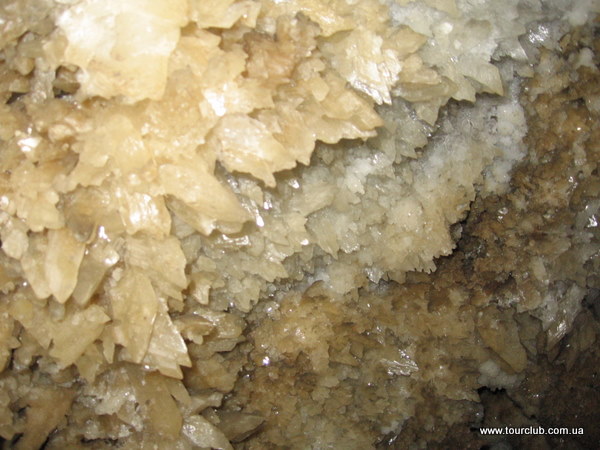
Chemogenic are sediments, formed chemically by settling out of sediments from the solution. Such sediments are the most spectacular in Atlantyda cave. A variety of gypsum crystals that grew on the cave walls and ceilings due to lakes, supersaturated with calcium sulphate, make the cave a unique mineralogical museum. From thin needles, which form tiny but dense thickets to huge, 1.5 m long, crystalline aggregates – this is a size range of gypsum crystals of the cave. Abundance of mineral forms and colors of crystal structures can impress anyone. Emotions and associations caused by contemplation of these magnificent works of nature, to some extent are concentrated in the names of grottoes and a hall: "Nizhnist"(tenderness), "Kvity"(flowers), "Zolota Osin"(golden autumn), "Chervoni Maky"(Red Poppies), "Khram Boghiv"(temple of the Gods) and so on. Detailed karst-speleological researches made in Atlantyda cave by the Institute of Geological Sciences of Academy of Sciences of Ukraine Soviet Socialist Repuplic and its research enterprise provided much valuable scientific information about patterns of caves development, history of the geological and geomorphologic formation of the area. History of the development of the cave system serves the basis for studies of huge gypsum caves of Transdniester. Atlantyda cave formation began at the end of the Neogene period, when the present deep river Zbruch valley did not exist, and the valley of the Dniester was in the initial state, with the form of a broad plain. Pressure waters were running down the cavities of the gypsum layer, dissolving effect of which turned cavities into huge karst channels. Downcutting of the Dniester valley and its left tributaries (including Zbruch) led to the opening of a gypsum layer and cave system, the main features of which had already been formed. This stage of the water free flow was accompanied with accumulation of the soft filler layer and beginning of slide and doline formation. Gypsum crystals grew under conditions of low rate flowing underground lakes. Further deepening of the river valleys led to complete draining of the cave. And over a long time it exists in close to present-day conditions.
Thus, Atlantida cave is a complex geological monument of nature, which has significant scientific and aesthetic value.
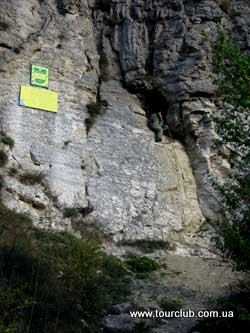 |
| entrance to the cave |
